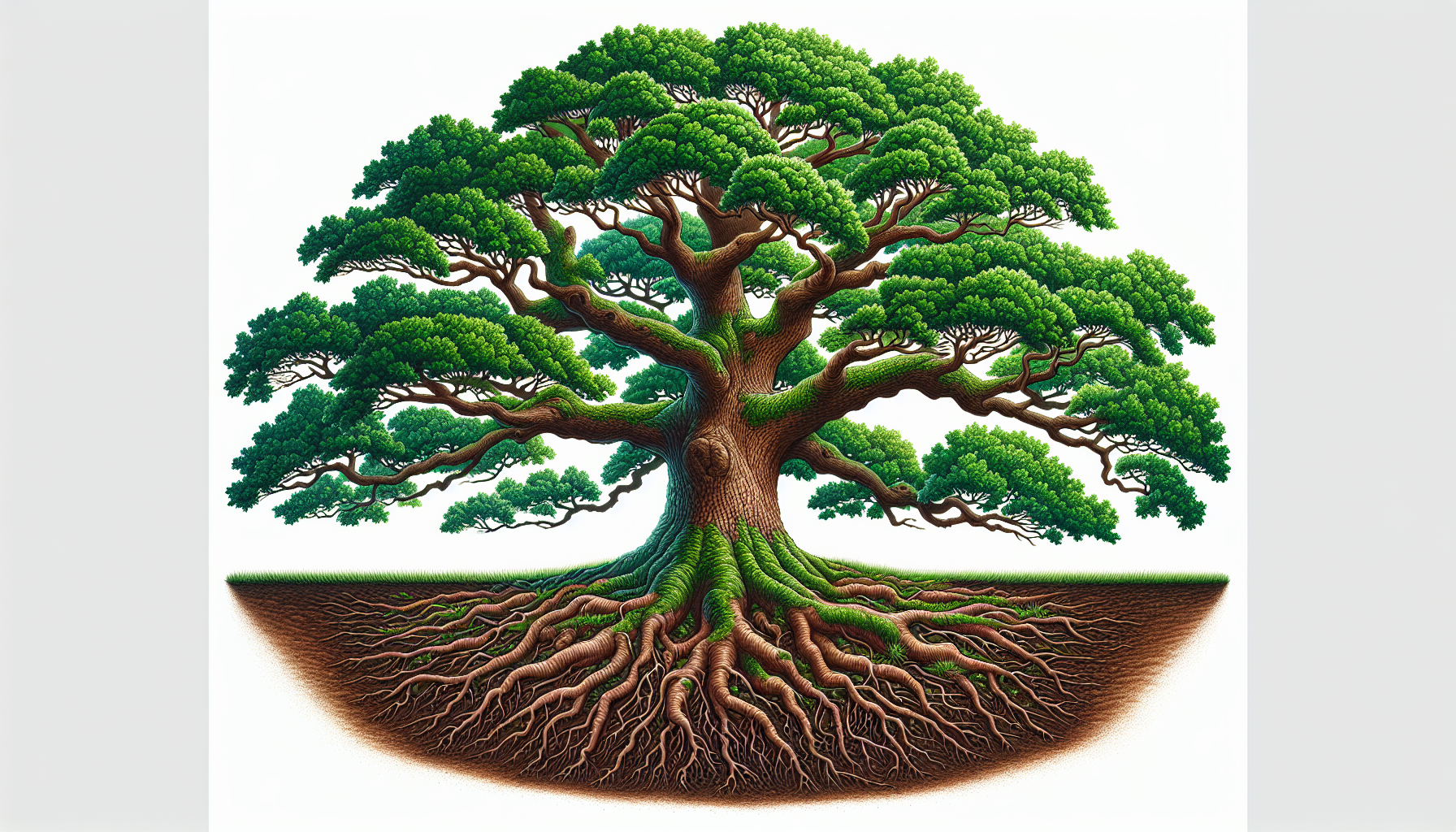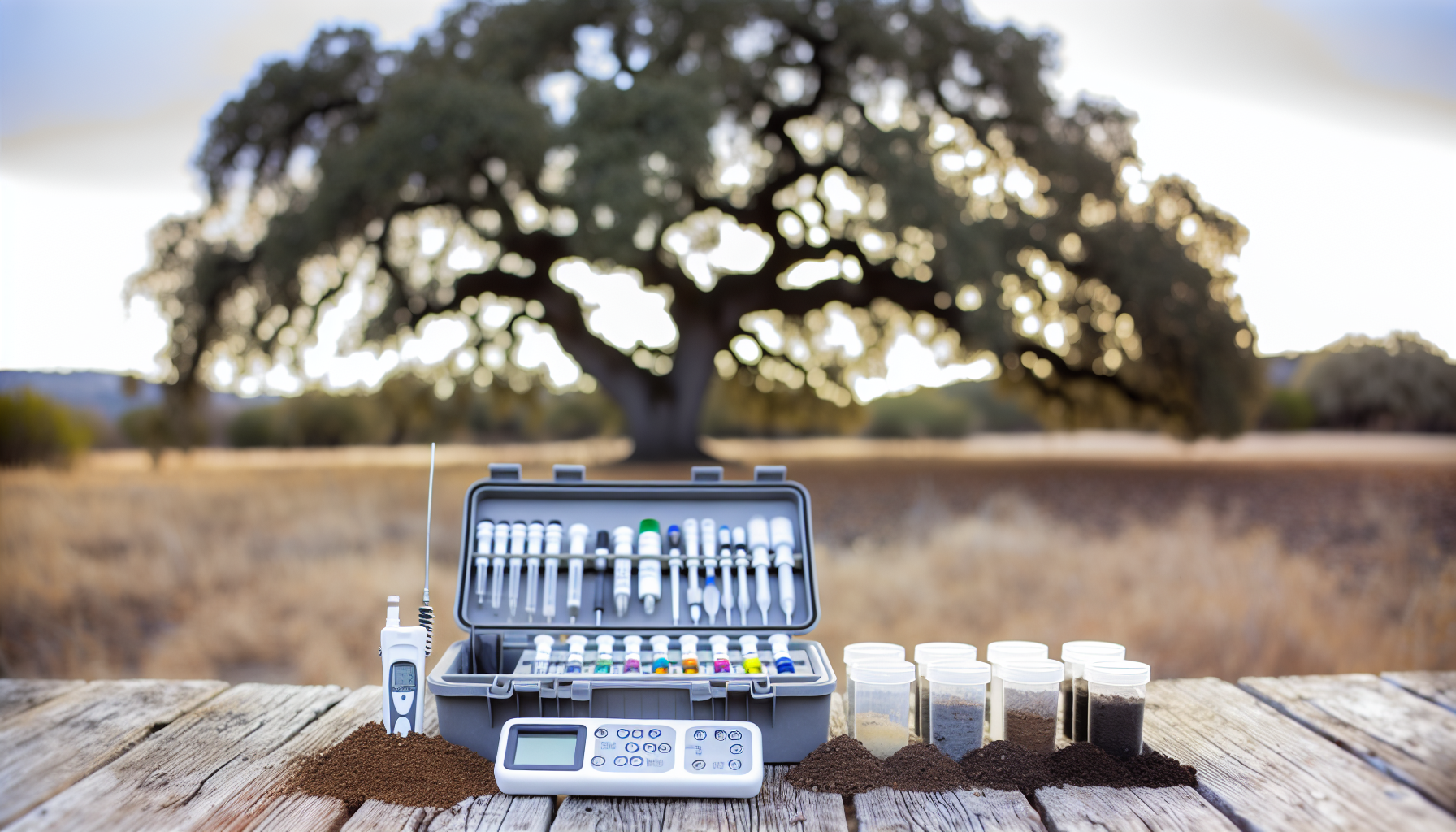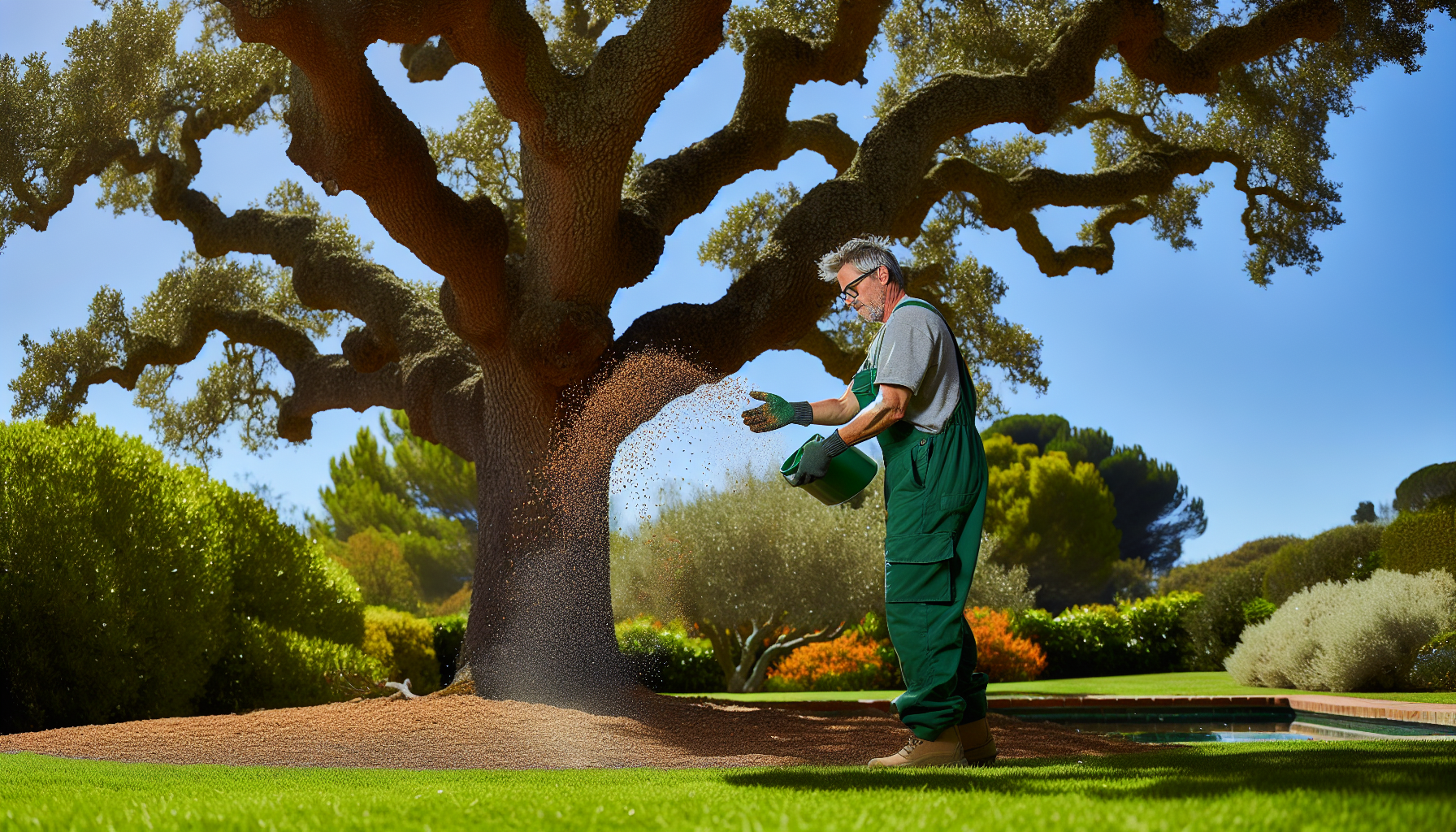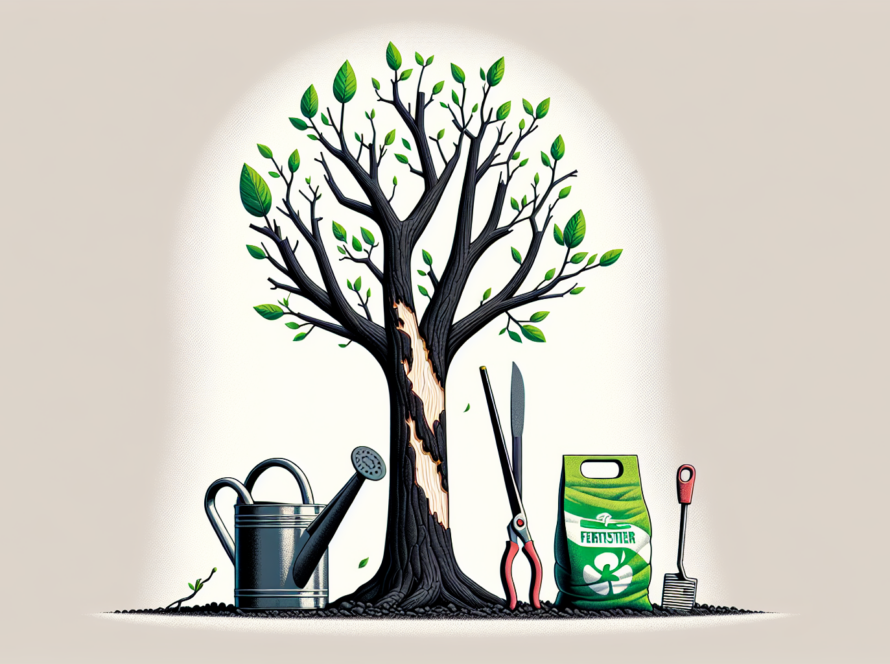If you’re wondering what kind of oak tree fertilizer to use, when to apply it, and how much your towering or young oaks need for optimal growth and health, you’re in the right place. This article cuts through the confusion to deliver clear, actionable advice on how to nourish your majestic oaks effectively.
Key Takeaways
Proper nutrition for oak trees is critical for their growth and resilience, with nitrogen enhancing leaf development and potassium strengthening roots. A custom fertilization program considering the tree’s age and soil conditions can enhance overall health.
When selecting a fertilizer, it is essential to evaluate soil conditions, tailor fertilization to the oak tree’s age and species, and choose between organic or synthetic options based on long-term tree and soil health.
Effective fertilization requires correct timing, application techniques, and continuous monitoring to adjust for over- or under-fertilization, ensuring a balanced approach with complementary practices such as watering and mulching.
Understanding the Essentials of Oak Tree Nutrition

The life of an oak tree is fundamentally shaped by nutrition; it underpins leaf development, strengthens roots, and bolsters resilience against diseases and pests. Whether you are the proud caretaker of a mature oak or are fostering the growth of younger oaks, understanding the nutrient needs of these trees is key to their vitality.
Though mature oaks may not always require additional supplements, a custom fertilization program can enhance the overall health of oaks at various growth stages.
The Role of Nitrogen in Foliage Vigor
If you’ve ever admired the bright green hue of oak leaves, you’ve witnessed the magic of nitrogen at work. This vital nutrient is the cornerstone of chlorophyll production and, subsequently, photosynthesis, which fuels the growth of these mighty plants. An appropriate nitrogen source, especially organic or slow-release types, provides a consistent nutrient delivery, promoting lush foliage in both young saplings and towering giants.
Consider the timing of your application; late winter and early spring are ideal for organic sources, while late spring suits inorganic options best, setting the stage for a year of lush growth.
Potassium: A Key to Strong Root Systems
Imagine the roots of an oak tree as its anchor, gripping the ground firmly to offer unmatched stability during nature’s trials. Potassium plays a pivotal role in this narrative, bolstering the root system that underpins efficient nutrient uptake and environmental resilience.
A well-nourished root network signals not just a tree’s health but also its capacity to withstand unpredictable elements such as gusts of wind or heavy rains.
Additional Nutrients for a Balanced Diet
While nitrogen and potassium are the headliners in the nutritional saga of oak trees, supporting actors like phosphorus and organic material can’t be overlooked. Phosphorus is instrumental in root development and overall growth, playing a key role in the tree’s metabolic processes. Simultaneously, organic material such as compost enriches the soil, fostering a vibrant ecosystem that nurtures our oaken friends.
The result? A balanced diet that propels these fruit trees, including newly planted trees and several trees, to their fullest potential, all supported by a strong tree trunk.
Selecting the Right Fertilizer for Your Oak Tree

Navigating the world of fertilizers can be daunting, but rest assured that finding the ideal match for your oak tree is a rewarding endeavor. The right fertilizer invigorates growth by addressing the specific needs of the trees based on their age, with less nitrogen required for mature oaks to avoid excessive, potentially problematic foliage. It’s a balancing act that takes into account the unique requirements of young oaks versus their older counterparts, as well as the distinctive needs of white oaks compared to red oaks.
Evaluating Soil Conditions and Fertilizer Types
Before choosing the perfect fertilizer, you must scrutinize the soil that nourishes your oak’s roots. Home soil test kits can reveal the pH levels, shedding light on the nutrients readily available to your tree. Armed with this knowledge, you can navigate the sea of fertilizer options – from granular to liquid to convenient spikes – and choose one that complements your tree’s specific needs.
Remember, the pH can make or break your tree’s ability to absorb micronutrients, making soil testing a non-negotiable step in your fertilization journey.
Tailoring Fertilization to Tree Age and Species
The approach to fertilization should reflect the differences between a young sapling and a grand, mature oak. Young oaks, in their formative years, should focus on establishing their root systems, holding off on fertilization until they’re ready to embrace a high-nitrogen mix designed to spur growth.
As oaks mature, a suitable granular fertilizer can support their continued development, with a keen eye on the specific needs of different species such as the steady seed-producers, white oaks.
Organic Versus Synthetic Fertilizers
When faced with the decision between organic and synthetic fertilizers, consider the long-term health of your soil and tree. Organic options like manure and compost not only feed your oak but also invigorate the soil, creating an environment where your tree can flourish.
Synthetic fertilizers, while more immediately impactful, come with the risk of burning roots and foliage if not applied judiciously. Thus, the choice of fertilizer is not just about what feeds your oak today, but what sustains it for the morrows to come.
How to Fertilize Your Oak Trees Properly

Fertilizing your oak tree is a subtle art, demanding comprehension of suitable timing, technique, and continuous monitoring.
For newly planted oaks, organic fertilizers like manure or compost can be worked into the soil to ensure the nutrients are within reach of eager roots. This method, when executed with care, can lead to a harmonious start for these young trees.
Timing Is Everything: When to Fertilize
Like all things, fertilization too has its own season. The timing of your application can mean the difference between a tree that thrives and one that merely survives. For mature oaks, late winter emerges as the ideal time to fertilize, just as the tree is gearing up for a burst of spring growth.
Red oaks, in particular, may benefit from an extra boost in the early fall, especially in warmer climates, to prepare them for the colder months ahead.
Techniques for Effective Fertilization
Fertilization might appear as easy as sprinkling nutrients and wishing for the best, but its real efficacy stems from the application method. To protect the roots and ensure nutrients reach the intended destination, spread fertilizer from the drip line to a few feet from the trunk, covering the area where roots are most active.
Whether you choose to broadcast spread, inject, or use stakes and spikes, the final step is a thorough watering to dissolve granules and deliver the nourishment deep into the soil.
Monitoring and Adjusting Your Approach
Post-fertilization, vigilance becomes your best companion. Monitoring your oak’s condition, from the vibrancy of leaves to the growth of twigs, offers clues on whether your fertilization strategy hits the mark. Adjustments might be necessary, especially if symptoms of over-fertilization, such as foliage yellowing or premature leaf drop, surface.
Remember, a balanced approach that includes watering, pruning, and mulching, alongside nutrient supplementation, paves the way to optimal overall tree health.
Special Considerations for Different Oak Varieties

Given their diversity, oak trees may necessitate different care and fertilization strategies. Some common varieties of oak trees include:
White oaks
Red oaks
Bur oaks
Pin oaks
Live oaks
Each variety brings its own set of needs to the table, influenced by factors like soil pH and micronutrient availability. Understanding these nuances can make the difference between a flourishing oak and one that merely gets by.
Caring for White Oaks and Red Oaks
The regal white oak and the stately red oak stand as pillars of strength, yet each requires a careful touch when it comes to nourishment. The ideal soil pH for white oaks hovers between 6.0 and 7.0, while red oaks share a similar preference for slightly acidic environments.
Tailoring your fertilization to these preferences, with slow-release formulas for white oaks and nitrogen-rich blends for red oaks, ensures that they not only survive but thrive in their respective habitats.
Fertilizing Oaks in Diverse Landscapes
For oaks rooted in varied landscapes, from open fields to dense woods, the approach to fertilization must adapt. Oaks in open areas may delight in the sun’s full embrace, rewarding you with a bounty of acorns, while those in forests might need a helping hand in the form of tree thinning to reach their full potential.
A balanced granular fertilizer, applied as the crown of spring unfurls, can be the catalyst for a mast that sustains wildlife for seasons to come.
Common Mistakes to Avoid When Fertilizing Oak Trees

As you commence the fertilization journey, remain vigilant to avoid pitfalls that could harm your oak. Overzealous application and negligence of environmental cues can turn a well-intentioned act into a harmful one.
Learning to sidestep these common errors can ensure your oak trees continue to reign with vigor and grace.
Over-Fertilization: More Is Not Always Better
In the sphere of oak care, moderation acts as the guiding light. Over-fertilization can lead to a buildup of mineral salts in the soil, disrupting the delicate microbial ecosystem and potentially causing root burn. If the leaves of your red oak begin to brown or display stunted growth, it may be time to reassess your fertilization quantities and remedy the situation with a gentle flush of water and the addition of natural mulch.
Incorrect Application Methods
Even the finest fertilizer, like TreeHelp Premium Fertilizer, can inflict damage if applied inappropriately. Concentrating nutrients too close to the trunk can overwhelm the tree’s system, leading to root damage that could have been easily avoided.
Spread the wealth of nutrients evenly beneath the oak’s canopy, paying attention to the drip line where the roots eagerly await their nourishment.
Ignoring Environmental Stressors
The impact of the environment on your tree’s health should never be underestimated. Drought or excessive rain can significantly impact how your oak responds to fertilization, with a lack of water hindering nutrient absorption and rendering your efforts fruitless.
Aligning your fertilization schedule with the rhythm of the local climate and maintaining soil moisture consistency ensures that your oak receives the full benefits of your care.
Summary
As we close the chapter on oak tree fertilization, remember that the key lies in understanding the specific needs of your oak, selecting the right fertilizer, applying it with precision, and adjusting your methods in harmony with the tree’s response. Embrace this knowledge, and your oaks will stand as living testaments to the care and respect they’ve been afforded, growing stronger and more magnificent with each passing season.
Frequently Asked Questions
What is the best fertilizer for oak tree?
Use a multipurpose 10-10-10 fertilizer for your oak tree, and apply it three or four times per year from late April to mid July. Liquid fertilizers like Miracle Gro can be mixed with water and applied in the same manner as watering the plant.
How do you help an oak tree thrive?
To help an oak tree thrive, ensure it receives full sun and at least four hours of direct sunlight daily. Water it deeply once a week, reaching the outer edges of the canopy.
Is 13 13 13 good for oak trees?
Yes, 13-13-13 granular fertilizer is good for oak trees and should be applied in early spring at a rate of 2 pounds per 1,000 square feet of crown.
How can I tell if my mature oak tree needs fertilization?
If you notice yellowing leaves, poor leaf growth, reduced leaf size, or a thinning canopy on your mature oak tree, it may indicate a need for fertilization adjustments. Keep an eye out for these signs to determine if your tree needs fertilization.
Is it better to use organic or synthetic fertilizer for my oak tree?
It’s generally better to use organic fertilizer for your oak tree as it enhances soil health and supports the ecosystem. However, the choice should be based on the specific needs and conditions of your tree and soil.




